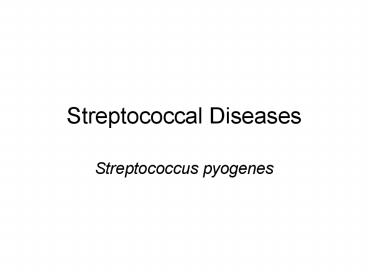Streptococcal Diseases - PowerPoint PPT Presentation
1 / 38
Title:
Streptococcal Diseases
Description:
Streptococcal Diseases Streptococcus pyogenes Streptococcus pyogenes Pyogenes means pus producing One of the most important pathogens Gram positive cocci in chains ... – PowerPoint PPT presentation
Number of Views:162
Avg rating:3.0/5.0
Title: Streptococcal Diseases
1
Streptococcal Diseases
- Streptococcus pyogenes
2
Streptococcus pyogenesPyogenes means pus
producing
- One of the most important pathogens
- Gram positive cocci in chains
- Lancefield Serological Group A
- Beta Hemolytic on blood agar
3
Gram Stain of S. pyogenes
4
Hemolysis on Blood Agar Plates
- Alpha hemolysis-organism excretes hemolysins
which partially break down rbc (incomplete
hemolysis) thus a greenish zone appears around
colony. S. pneumoniae - Beta hemolysis-organisms excretes potent
hemoysins which completely lyse rbc (complete
hemolysis) thus a clear zone appears around
colony. S. pyogenes
5
S.pyogenes
S. pneumonia
Beta hemolysis
Alpha hemolysis
6
Diseases caused by S. pyogenes
- Strep throat
- Impetigo
- Erysipelas
- Cellulitis
- Invasive Strep A infections
- Necrotizing fasciitis
- Myositis
- Toxic shock-like syndrome
7
(No Transcript)
8
Erysipelas
- Acute infection and imflammation of the dermal
layer of skin. - Painful red patches which enlarge and thicken
- Treatment -penicillin or erythromycin
9
Erysipelas
10
Strep Throat
- Most common of all Strep diseases
- Spread by saliva or nasal secretions
- Incubation period 2-4 days
- Sore throat, slight fever (101)
- Important to treat immediately to avoid post
strep diseases
11
Diagnosis and treatment of Strep Throat
- Tell tale symptoms are slight fever associated
with sore throat and visual of pus in back of
throat - Quick diagnostic tests (Molecular) available but
must be confirmed by throat swab and growth on
blood agar (beta hemolysis)
12
Diagnosis and treatment of Strep Throat
- If the strain of S. pyogenes is lysogenic for a
particular phage which expresses an erythrogenic
toxin the result is Scarlet fever - Rash appears and characteristic is the strawberry
colored tongue
13
Strawberry Tongue
14
Treatment of Strep
- Penicillin G or Erythromycin are drugs of choice
- Although the disease is self-limiting it is
important to treat immediately to avoid post
strep complications
15
Poststreptococcal diseases
- Rheumatic Fever-autoimmune disease involving
heart valves,joints, nervous system. Follows a
strep throat - Acute glomerulonehritis or Brights
Disease-inflamatory disease of renal glomeruli
and structures involved in blood filter of
kidney. Due to deposition of Ag/Ab complexes
16
Rheumatic Fever
- Most common cause of permanent heart valve damage
in children - Exact cause not yet known but there appears to be
some antibody cross reactivity between the cell
wall of S. pyogenes and heart muscle
17
Rheumatic Fever
- Diagnosis is based on symptoms and is difficult
- Occurs most frequently between ages of 6 and 15
- US it is about 0.05 of pop having strep
infections - 100x more frequent in tropical countries
18
Rheumatic Fever
- Treatment is via salicylates (aspirin
derivatives) and corticosteroids to decrease
inflammation and fever.
19
Glomerular Nephritis
- Diagnosis based on history of Strep throat and
clinical findings. - Symptoms include fever, malaise,edema,
hypertension and blood or protein in urine - Occurs in 0.5 of those having strep throat.
20
Glomerular NephritisTreatment and Recovery
- Penicillin or erythromycin to eradicate and
residual strep infection - 80-90 of cases recover with bed rest lasting for
months - Kidney damage in the remainder is often permanent
resulting in chronic glomerular nephritis
21
Streptococcus Pneumonia
- Caused by infection with Streptococcus pneumoniae
- Gram positive, alpha hemolytic, not of lancefield
serotype A - Often part of normal flora of respiratory track
and becomes infective once hosts resistance is
lowered. Classified as an endogenous infection.
22
Strep Pneumonia
23
Strep Pneumonia
S. pneumoniae Alpha hemolysis
24
Strep pneumonia
- Predisposing factors upper respiratory viral
infection, diabetes, alcoholism - 60-80 of all pneumonias
25
Strep Pneumonia
26
Cause of strep pneumonia
- Primary virulence factor is the capsular
polysaccharide which protects the organism
against phagocytosis - Pathogenesis is due to rapid growth of bacteria
in alveolar spaces
27
Symptoms of Strep Pneumonia
- Onset abrupt
- Chest pains
- Chills
- Labored breathing
28
Diagnosis of Strep pneumonia
- Chest Xray
- Culture and staining
- Biochemical tests of isolated organism
29
Treatment of Strep Pneumonia
- Typically treated with Penicillin G cefotaxime,
oflaxacin or for those allergic to penicillins
can be treated with erythromycin or tetracycline - Pneumococcal vaccine (Pneumovax 23 or Pnu-immune
23) is available for the elderly
30
Staphylococcal infections
- One of the most common of all infections
- Staphylococcus are divided into pathogens and non
pathogens based on possession of the enzyme
coagulase - Coagulase are usually S. aureus and pathogenic
- Coagulase - are organisms like S. epidermidis are
less invasive
31
Diseases of Staphylococcus
32
Toxic Shock Syndrome
- Most in women using superabsorbant tampons
- Staphylococcus aureus-Gram positive cocci
- Low blood pressure, fever, diarrhea, skin rash
can be fatal
33
Toxic Shock Syndrome
- Symptoms mainly caused by toxic shock syndrome
toxin 1(TSST1) - Several other enterotoxins also involved
34
Staph skin infections
- Most common cause of acne, boils, furuncle and
cabuncles - Treatment can be difficult because of antibiotic
resistance.Usually can be treated with
methicillin, cephalosporins,or vancomycin - Methicillin resistant strainsMRSA
35
Staph skin infections
Furuncle (infected hair follicle
Deep folliculitis
superficialfolliculitis
Carbuncle Multiple abcesses Around many
hair follicles
Scalded skin syndrome
Staph impetigo
36
Scalded Skin Syndrome
- Due to strains of S. aureus containing a special
toxin-exfoliatin
37
Diagnosis
- Culture and stain-gram positive in grape-like
clusters - Catalase and coagulase tests
- DNA fingerprinting
38
S. aureus































